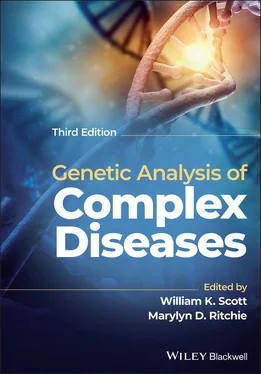Genetic Analysis of Complex Disease
Здесь есть возможность читать онлайн «Genetic Analysis of Complex Disease» — ознакомительный отрывок электронной книги совершенно бесплатно, а после прочтения отрывка купить полную версию. В некоторых случаях можно слушать аудио, скачать через торрент в формате fb2 и присутствует краткое содержание. Жанр: unrecognised, на английском языке. Описание произведения, (предисловие) а так же отзывы посетителей доступны на портале библиотеки ЛибКат.
- Название:Genetic Analysis of Complex Disease
- Автор:
- Жанр:
- Год:неизвестен
- ISBN:нет данных
- Рейтинг книги:4 / 5. Голосов: 1
-
Избранное:Добавить в избранное
- Отзывы:
-
Ваша оценка:
- 80
- 1
- 2
- 3
- 4
- 5
Genetic Analysis of Complex Disease: краткое содержание, описание и аннотация
Предлагаем к чтению аннотацию, описание, краткое содержание или предисловие (зависит от того, что написал сам автор книги «Genetic Analysis of Complex Disease»). Если вы не нашли необходимую информацию о книге — напишите в комментариях, мы постараемся отыскать её.
An up-to-date and complete treatment of the strategies, designs and analysis methods for studying complex genetic disease in human beings Genetic Analysis of Complex Diseases
Genetic Analysis of Complex Diseases
Genetic Analysis of Complex Diseases
Genetic Analysis of Complex Disease — читать онлайн ознакомительный отрывок
Ниже представлен текст книги, разбитый по страницам. Система сохранения места последней прочитанной страницы, позволяет с удобством читать онлайн бесплатно книгу «Genetic Analysis of Complex Disease», без необходимости каждый раз заново искать на чём Вы остановились. Поставьте закладку, и сможете в любой момент перейти на страницу, на которой закончили чтение.
Интервал:
Закладка:
One of the characteristics of a genetic disorder is that it aggregates, or clusters, within families. If familial clustering of a disorder is observed, there are several approaches described below to determine if this observation is statistically significant. However, keep in mind that familial clustering may also be due to a common familial environment or simply due to chance. So, while statistical evidence of familial clustering may support the involvement of genetics in the disorder under investigation, it will be necessary to identify the underlying genes to confirm this.
Family History Approach
In this approach, one ascertains the presence or absence of family history in study participants (with and without the condition) and then tests for statistically significant associations between family history and the condition. Khoury et al. (1993) defines three variations on this approach, depending on the level of detail obtained on the relatives. The Abbreviated Family History Approach involves simply questioning the study participants on the presence or absence of the condition in other family members. This method is by far the fastest and cheapest, but also the most susceptible to misclassification because no effort is made to confirm the participant responses. That is, the investigator is relying on the accuracy of the informant’s memory or perception of the family members, rather than directly observing the condition in the relatives. The Detailed Family History Approach requires the investigator to obtain detailed information regarding disease status (including age of onset) and demographic characteristics on each family member. This is the approach routinely utilized in genetic studies. Because the information requested on each family member is more detailed, there is less likelihood of misclassification as with the abbreviated approach. Finally, one can examine and/or interview the relatives directly. This is referred to as the Family Study Approach . Often in this approach, medical records are also reviewed in order to confirm the presence or absence of the condition in the relatives. While time‐consuming and more expensive, this approach certainly provides the most accurate information regarding the family history of a trait.
Once the necessary information has been collected, there are several methods to test for statistically significant association between family history and the condition. If the study design is case‐control, the presence or absence of family history may be treated as a “risk factor” for disease, and the standard epidemiologic 2 × 2 table may be used:
| Family history | ||
|---|---|---|
| Disease in study participant | + | − |
| + | a | b |
| − | c | d |
From here, an odds ratio may be calculated:
(3.1) 
The odds ratio derived here is then a measure of the association between family history and the condition. In this case, the odds ratio is the odds of having a positive family history in individuals with the condition compared with the odds of having a positive family history in individuals who are unaffected. This is not to be confused with a risk ratio, which is a prospective measure with respect to an individual’s affection status. That is, the risk ratio is the ratio of the incidence of the condition in individuals with a positive family history compared with those who have a negative family history. However, when the incidence of the condition is low, the odds ratio should closely approximate the risk ratio (Rothman and Greenland 1998).
In keeping with the epidemiologic approach, one can also measure the amount of the disease that can be “attributed” to the presence of a positive family history. This in effect provides information regarding what proportion of the disease is due to genetic causes. There are several methods for calculating attributable fractions , depending on what information is available. Khoury et al. (1993) reviews three of these formulas (Levin 1953; Kelsey et al. 1986; Miettinen 1974) in their book. The Miettinen formula is given below:
(3.2) 
Example of Calculating Attributable Fraction
In a population‐based study examining the contribution of sickle cell disease to the occurrence of developmental disabilities, the Miettinen formula ( Equation 3.2) was applied to demonstrate that 34% of the cases of stroke‐related developmental disabilities in black children were due to sickle cell disease (Ashley‐Koch et al. 2001). In this example, the fraction of cases with stroke‐related disabilities with the risk factor (sickle cell disease) was 0.34 (13 children with sickle cell disease among a total of 38 children with stroke‐related developmental disabilities), and the relative risk was 130. Thus, the attributable fraction by the Miettinen formula is 34% (0.34 * (129/130)).
For all the ease with the family history approach, there are several pitfalls that may occur. One should be aware that a positive family history is a function of many things, including the frequency of the condition in the general population, the size of the family, the natural history of the condition, the underlying genetic mechanism, and possibly shared environmental exposures. For example, if a condition is relatively common in the population, a positive family history may simply result from the presence of phenocopies in the family. Also, in a condition with late onset, young relatives may be misclassified as “disease‐free” (i.e. they may not express the condition simply because they are too young to express it). For example, if one is studying Alzheimer disease and finds that a 55‐year‐old sibling of an affected proband has no signs of dementia, one should re‐examine that sibling at regular intervals to determine if he/she remains asymptomatic over time. It is possible that, at the age of 55 years, the sibling is too young to express symptoms. However, if he/she were re‐examined at 60 years of age, he/she would exhibit symptoms. Thus, if the only physical examination for that sibling was performed at 55 years of age, he/she would be classified as “normal.” But if another physical examination was performed at the age of 60 years, then the individual would be classified as “affected.” Thus, whenever resources allow, follow study participants over time for changes in affection status. In addition to variation in the age of onset of a condition, there may be variable expression of the condition. Therefore, family members who have minor manifestations of the condition or are in the early stages of the disease process may not be recognized as expressing the condition. Furthermore, in complex genetic disorders, individuals in the family may not express the disorder because they possess only a fraction of the necessary genetic and environmental factors to express the condition. For all these reasons, one may want to examine the association of family history with several types of relatives in order to make sure that the same conclusion is reached for all relative types.
Correlation Coefficients
Another simple approach to determining familial aggregation is the use of scatter plots. In the case of a quantitative trait, plotting the trait measurement of one relative against the trait measurement of another relative will provide the correlation of the trait among the pair. The slope of the line that is formed by the data is the square of the correlation coefficient. As shown later in the chapter, the correlation coefficient can also provide information regarding the heritability of a trait. Figure 3.3examines the correlation of age of onset of Alzheimer disease among affected siblings. These data were randomly selected from a larger study examining the genetic contribution to the age at onset in Alzheimer and Parkinson disease (Li et al. 2002). The proband’s age of onset was plotted against the sibling’s age of onset. The resulting slope of the line was 0.16, corresponding to a Pearson correlation coefficient of 0.40 ( p < 0.0001, n = 400 sibling pairs), suggesting that there is a significant correlation of age of onset among siblings affected with Alzheimer disease. Khoury and colleagues (1985) demonstrate the use of the loglinear model to determine correlation for qualitative traits.
Читать дальшеИнтервал:
Закладка:
Похожие книги на «Genetic Analysis of Complex Disease»
Представляем Вашему вниманию похожие книги на «Genetic Analysis of Complex Disease» списком для выбора. Мы отобрали схожую по названию и смыслу литературу в надежде предоставить читателям больше вариантов отыскать новые, интересные, ещё непрочитанные произведения.
Обсуждение, отзывы о книге «Genetic Analysis of Complex Disease» и просто собственные мнения читателей. Оставьте ваши комментарии, напишите, что Вы думаете о произведении, его смысле или главных героях. Укажите что конкретно понравилось, а что нет, и почему Вы так считаете.











